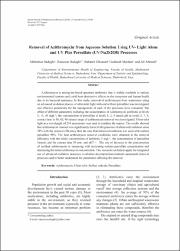| dc.contributor.author | Sadeghi, Mehraban | en_US |
| dc.contributor.author | Sadeghi, Ramezan | en_US |
| dc.contributor.author | Sadeghi, Ramezan | en_US |
| dc.contributor.author | Mardani, Gashtasb | en_US |
| dc.contributor.author | ahmadi, ali | en_US |
| dc.date.accessioned | 1399-07-09T06:55:39Z | fa_IR |
| dc.date.accessioned | 2020-09-30T06:55:39Z | |
| dc.date.available | 1399-07-09T06:55:39Z | fa_IR |
| dc.date.available | 2020-09-30T06:55:39Z | |
| dc.date.issued | 2018-12-01 | en_US |
| dc.date.issued | 1397-09-10 | fa_IR |
| dc.date.submitted | 2017-08-20 | en_US |
| dc.date.submitted | 1396-05-29 | fa_IR |
| dc.identifier.citation | Sadeghi, Mehraban, Sadeghi, Ramezan, Sadeghi, Ramezan, Mardani, Gashtasb, ahmadi, ali. (2018). Removal of Azithromycin from aqueous solution using UV- light alone and UV plus Persulfate (UV/Na2S2O8) processes. Iranian Journal of Pharmaceutical Research, 17(2), 54-64. doi: 10.22037/ijpr.2018.2371 | en_US |
| dc.identifier.issn | 1735-0328 | |
| dc.identifier.issn | 1726-6890 | |
| dc.identifier.uri | https://dx.doi.org/10.22037/ijpr.2018.2371 | |
| dc.identifier.uri | http://ijpr.sbmu.ac.ir/article_2371.html | |
| dc.identifier.uri | https://iranjournals.nlai.ir/handle/123456789/312162 | |
| dc.description.abstract | Introduction. Azithromycin is among the broad-spectrum antibiotics that is widely available in various environmental systems and could have destructive effects on the ecosystem and human health due to its bacterial resistance. In this study, removal of azithromycin from wastewater using an advanced oxidation process of ultraviolet light with and without persulfate was investigated and effective parameters for the management of each of the processes were evaluated. Material and method. The effect of different parameters including the concentration of Azithromycin antibiotic at levels 5, 15, 45 mgL-1; the concentration of persulfate at levels 1, 2, 4 mmol; pH at levels 5, 7, 9, contact time in 30, 60, 90 minute range of azithromycin removal was investigated. Ultraviolet light at a wavelength of 254 nanometers was used to irradiate of the reactor. Results and discussion. The results showed that azithromycin removal was significantly lower in the presence of ultraviolet radiation alone 58% with the removal efficiency than the case that ultraviolet radiation was used with sodium persulfate 98%. The best azithromycin removal conditions were obtained at the removal efficiency with the initial concentration of antibiotic 5 mgL-1, the concentration of persulfate 1mmol, the contact time 30 min and pH=7. The rate of decrease in the concentration of residual azithromycin is increasing with increasing sodium persulfate concentration and decreasing the initial azithromycin concentration. Conclusion. This research can help to apply the integrated use of advanced oxidation processes to idealize decomposition-resistant compounds removal processes and to better understand the parameters affecting the removal. | en_US |
| dc.format.extent | 533 | |
| dc.format.mimetype | application/pdf | |
| dc.language | English | |
| dc.language.iso | en_US | |
| dc.publisher | School of Pharmacy, Shahid Beheshti University of Medical Sciences | en_US |
| dc.relation.ispartof | Iranian Journal of Pharmaceutical Research | en_US |
| dc.relation.isversionof | https://dx.doi.org/10.22037/ijpr.2018.2371 | |
| dc.subject | Azithromycin | en_US |
| dc.subject | ultraviolet | en_US |
| dc.subject | Sulfate radicals | en_US |
| dc.subject | Persulfate | en_US |
| dc.subject | HPLC | en_US |
| dc.subject | toxicology and Pharmacology | en_US |
| dc.title | Removal of Azithromycin from aqueous solution using UV- light alone and UV plus Persulfate (UV/Na2S2O8) processes | en_US |
| dc.type | Text | en_US |
| dc.type | Research article | en_US |
| dc.contributor.department | Department of Environmental Health Engineering, School of Health, Shahr-e-kord University of Medical sciences, Shahr-e-kord, Iran. | en_US |
| dc.contributor.department | Department of Environmental Health Engineering, School of Health, Shahr-e-kord University of Medical sciences, Shahr-e-kord, Iran. | en_US |
| dc.contributor.department | Department of Environmental Health Engineering, School of Health, Shahrekord University of Medical sciences, Shahrekord, Iran. | en_US |
| dc.contributor.department | Department of Environmental Health Engineering, School of Health, Shahr-e-kord University of Medical sciences, Shahr-e-kord, Iran. | en_US |
| dc.contributor.department | Department of Statistics and Epidemiology, School of Health, Shahr-e-kord University of Medical Sciences , Shahr-e-kord, Iran. | en_US |
| dc.citation.volume | 17 | |
| dc.citation.issue | 2 | |
| dc.citation.spage | 54 | |
| dc.citation.epage | 64 | |





